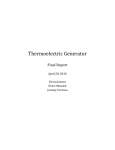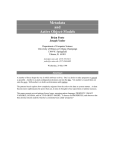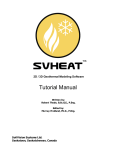Download Thermoelectric Generator
Transcript
Thermoelectric Generator User’s Manual April 27, 2010 Kevin Jensen Drew Messick Jeremy Verzosa Table of Contents Introduction .................................................................................................................................................. 3 Installation .................................................................................................................................................... 5 Operation ...................................................................................................................................................... 6 Storage .......................................................................................................................................................... 8 Safety and Precautions ............................................................................................................................... 10 2 Introduction The Thermoelectric Generator is designed with one sole purpose in mind, to provide a source of electric energy from a natural source. This device will allow the user to charge a cell phone or laptop within the comfort of their home with resources found in nature. Firewood inside a fireplace used to heat a home will have an alternative purpose with the Thermoelectric Generator, which is to provide electricity without the financial cost. The Thermoelectric Generator consists of many parts including, but not limited to the following: 1. A boiler is a closed, metal encasement containing water that is placed within a fireplace. The water is boiled, converting it into steam to flow through the thermosyphon. 2. A household outlet allows you to plug in a small electric device (i.e. cell phone or laptop chargers). 3. A temperature gauge will indicate the temperature at which the TEGs are at. 4. Two switches allowing you to turn off the fans, LED and inverter for storage. Figure 1: Boiler, boiler gauge and outlet location 5. A thermosyphon is a pipe that creates a pathway for steam to flow up to the thermoelectric generators distributing heat to the “hot” side of the thermoelectric generators. 6. Condensing coils which is copper tubing that will allow steam to cool and be stored in a holding tank to be reused by the boiler. 7. A holding tank will store water from condensing coils. 3 Figure 2: Thermosyphon, holding tank and condensing coils location 8. Thermoelectric generators are devices that use a difference in temperature (hot side and cold side difference) to output an electric current from a heat source (referred to as TEGs at times). 9. A cooling system which consists of two fans helping to create the temperature difference from the top side of the TEGs to the bottom, which is very important for the TEGs to operate optimally. Figure 3: Cooling system and thermoelectric generators location 10. A sealed lead acid battery (SLA) will provide power to an outlet and can be recharged by the electric current provided by the TEGs. 11. An LED lets you know when the battery voltage is sufficient enough to charge a device. 4 Installation To install the Thermoelectric Generator, connect the boiler pipes to the encasement pipes at the union joints as pictured in Figure 4. Twist both union joints by hand until tight. After the pipes have been secured together, place the boiler in the middle of your fireplace and the encasement of the Thermoelectric Generator on your hearth. Make sure that the pressure and temperature gage, shown in Figure 5, is facing away from the fire. Figure 4: Union Joint Connection Figure 5: Pressure and Temperature Gage 5 Operation The Thermoelectric Generator is a boiler system that needs to be treated with extreme care. The procedure described below should be followed closely to ensure safe operation. (For more information on safety concerns see Safety and Precautions on page 8.) 1. Position the Thermoelectric Generator on the hearth of the fireplace as shown in Figure 6 below. The boiler should extend into the fireplace. Boiler Fireplace Generator Hearth Figure 6: Top down view of Thermoelectric Generator placement 2. Ensure the ball valve #1 is open, ball valve #2 is open and ball valve #3 is closed. See Figure 7 for location of the ball valves. The ball valves are open when the handle is aligned (same direction) with the pipe and closed when the handle is perpendicular (at a 90° angle) to the pipe. Boiler Gage Ball Valve #1 Ball Valve #2 Ball Valve #3 Figure 7: Ball valve and boiler gage location 3. Using the provided funnel, pour 2 quarts (1.9 liters) of water into the holding tank through ball valve #2. Briefly open ball valve #3 to allow water to flow to the boiler. Ensure that ball valve #3 is closed before moving on to the next step. (Note: Whenever opening valves, there is always the possibility that hot water or steam will escape. Therefore, always open valves carefully while wearing protective gloves.) 4. Light a fire in the fireplace. 6 5. Watch for the temperature on the boiler gage to begin increasing. Open the panel allowing access to the holding tank and condensers. When steam begins to come out of ball valve #1, close the valve. The panel may also be closed. 6. Turn on both of the switches. If the LED light lights up, a device can be plugged in. If the LED does not light up, switch off the bottom switch to turn off the inverter and charge the battery. When the LED lights up, the bottom switch can be turned on and something can be plugged in. 7. During operation, if the LED light ever turns off, turn off the bottom switch and allow the battery to recharge. Once the LED light comes on again, the bottom switch can be turned on again and something can be plugged in. 8. After approximately every 30 minutes of operation, the boiler needs to be refilled (Note: This time will vary based on the temperature of the fire. However, performing this action too often will not cause any negative effects). Do this by closing ball valve #2 and briefly opening ball valve #3. Once ball valve #3 is closed again, open ball valve #2 to allow pressure to vent and to allow condensed water to return to the holding tank. (Note: If you notice that large amounts of steam are coming from the condensing tubes in addition to the condensed water, you will need to refill the holding tank manually using the included funnel. Refer to step 3.) 9. When you are finished with the generator, turn off both switches and allow the fire to die out and cool completely. Only after the fire has completely cooled should the generator be disassembled and moved. The pipes will remain hot for a period of time even after the fire has died. Always wear protective gloves when touching exposed metal parts to prevent the risk of burns. 10. To drain the device, put a pot or bucket under the lower union fitting and loosen it until water begins to come out. Once all the water is drained, loosen the top union fitting to allow the boiler section to be removed. The generator can now be stored. 7 Storage Turn the both of the switches on the user interface to the off position as shown in Figure 8 and wait for the boiler to cool down to room temperature. This should take approximately 30 minutes after the fire is extinguished. Before storing the generator, the water must be drained from the system. Make sure that the ball valve from the hold holding ing tank has been turned to the off position as shown in Figure 9.. Place a bowl underneath the union joints and loosen the union joints. Let the water drain out of the pipes. Once the water has nearly stopped dripping, pull the boiler away from the rest res of the generator to disconnect the pipes. Tilt the boiler so that the rest of the water in the boiler drips into the bowl. If necessary, empty the bowl and place it back underneath the end of the pipes before draining the holding tank. Turn the ball valve alve at the bottom of the holding tank to the on position as shown in Figure 9 and let the tank drain into the bowl. Once it has drained, tilt the generator away from the pressure and temperature gage (Figure Figure 5 in Installation section) to drain the remaining ing water from the generator. Discard all water that has been used while running the generator. Figure 8: Switches (Off Position) Figure 9:: Ball valve in the off position (left) and ball valve in the on position (right) 8 Once the water has been discarded, the Thermoelectric Generator is ready for storage. Store the encasement of the generator in its upright operating position. For space conservation, store the boiler as shown in Figure 10 below. Figure 10: Storage Recommendation 9 Safety and Precautions This device can be very harmful and must be used with extreme care and guidance. Many parts are made of metal that will be exposed to temperatures around 100°C and will heat up very quickly, making them too hot to touch. • • • • • • • • • DO NOT allow children to handle the generator without adult supervision and extreme care. Burns may occur if you touch the metal piping. DO NOT attempt to place boiler in your fireplace while fire has already started. DO NOT attempt to remove the boiler from the fireplace while there is a fire in the fireplace. DO NOT touch metal parts (the boiler, the thermosyphon, any valves, the condensing tubes, or even holding tank) without allowing for proper cooling. DO NOT touch valves when adjusting water levels without gloves or mittens. DO NOT insert anything other than a two or three pronged plug into the NEMA type B outlet. DO NOT plug a device in to the outlet while the LED is not lit. DO NOT horseplay around the device to prevent burns or injury from occurring. DO NOT attempt to use the device for anything requiring above a 12W load. IMPORTANT NOTE: If the boiler gauge pressure exceeds 5 psi, open the panel leading to the condensing coils and immediately open valve #1 to release the pressure. Allow the fire to die out and remove the generator from the fireplace. The generator will need to be serviced before it can be used again. 10
















